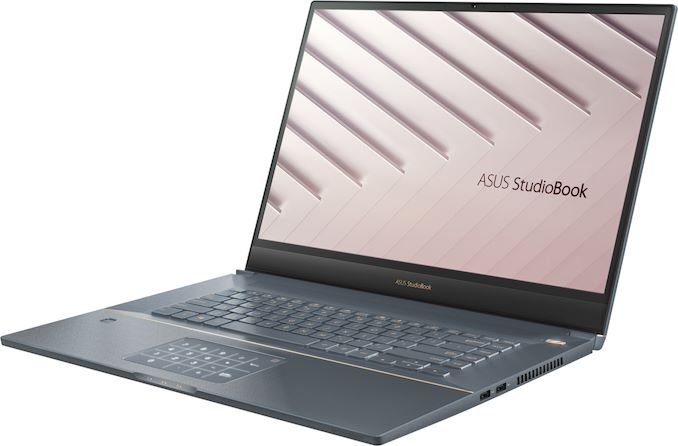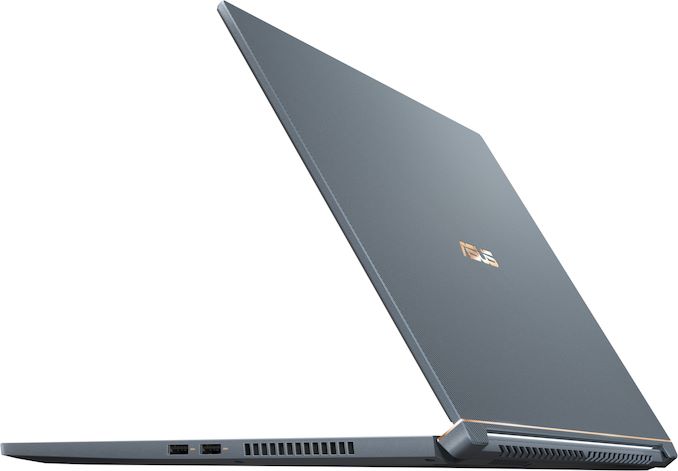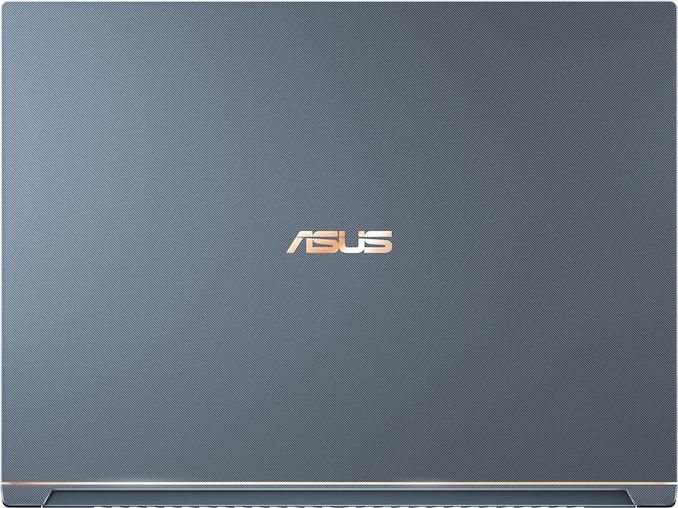CES 2019: ASUS Reveals StudioBook S W700 Workstation with Xeon & Quadro
by Anton Shilov on January 17, 2019 3:00 PM EST
At CES this year, ASUS introduced its first mobile workstation aimed at professionals who work with graphics applications. The new system can be equipped with six-core Intel Core or Xeon processors, NVIDIA’s Quadro GPUs, and a factory-calibrated 17-inch display panel validated by Pantone.
These days a leading supplier of premium laptops for consumers, gamers, and prosumers, ASUS inevitably needed a new market to enter in a bid to keep its PC market share growing. Mobile workstations are a relatively niche market controlled primarily by Dell, HP, and Lenovo, but it is very stable in terms of volumes and also offers rather lucrative margins. Since ASUS clearly knows how to build competitive PCs, it's not surprising to see the company try its luck with mobile workstations.
The ASUS StudioBook S W700-series comes in a Turquoise Grey aluminum chassis and is based on Intel’s six-core Core i7-8750H or Xeon E-2176M processors, and are accompanied by NVIDIA’s Quadro P3200 GPU with 6 GB of GDDR5 memory. To cool down the powerful CPU and GPU, ASUS uses a cooling system featuring five heat pipes, and I suspect is similar to the coolers used for the company’s gaming notebooks.
Depending on exact model, the system may be equipped with up to 64 GB of DDR4-2667 memory (with or without ECC support in case of Xeon) and up to two M.2 PCIe/NVMe SSDs (2TB each), which can be further put RAID 0/1 mode.
One of the key components of any graphics workstation is of course its display. ASUS outfits its StudioBook S W700-series with its 17-inch NanoEdge anti-glare 8-bit display panel, which sports a 1920×1200 resolution and 178° viewing angles. The display has also been validated by Pantone; it can reproduce 97% of the DCI-P3 color space, and it is factory calibrated to Delta E < 2 color accuracy.
Moving on to connectivity, the StudioBook S has an 802.11ax + Bluetooth 5.0 controller, a Thunderbolt 3 port (enabled by Intel’s latest ‘Titan Ridge’ JHL7340 controller), three USB 3.1 Gen 2 Type-A ports, one HDMI 2.0 port, an SD 4.0/UHS-II card reader, and a 3.5-mm headphone jack. The laptop is also equipped with an HD webcam, a microphone array, a fingerprint reader, a keyboard with a 1.4 mm travel distance, and a touchpad with numbers that can be used like a numpad for the calculator app.
Courtesy of its relatively thin 5.3-mm LCD bezels, the 17-inch screen fits in a chassis that is comparable to those used for 15-inch mobile workstations (which tend to be pretty bulky anyhow). The z-height of the ASUS StudioBook S is 1.84 cm, whereas its weight is around 2.39 kilograms
| The ASUS StudioBook S General Specifications | |||||
| W700G3P | |||||
| Display | Diagonal | 17" | |||
| Resolution | 1920×1200 | ||||
| Color Gamut | DCI P3: 97% | ||||
| CPU | Intel Xeon E-2176M processor: 6C/12T, 2.7 - 4.4 GHz, 12 MB Intel Core i7-8750H processor: 6C/12T, 2.2 - 4.1 GHz, 9 MB |
||||
| RAM | Up to 64 GB DDR4-2667 with or without ECC | ||||
| Graphics | NVIDIA Quadro P3200 with 6 GB of memory | ||||
| Storage | Up to two PCIe 3.0 x4 SSDs | ||||
| Wi-Fi | 2×2 802.11ax Wi-Fi module | ||||
| Bluetooth | BT 5.0 | ||||
| General Ports | 1 × Thunderbolt 3 for data, display output (DP 1.4) 3 × USB 3.1 Gen 2 1 × HDMI 2.0 1 × SD/UHS-II card reader |
||||
| Other I/O | HD webcam, TRRS connector for audio, speakers, microphone array | ||||
| Dimensions (H × W × D) | 38.2 × 28.6 × 1.84 cm 15.03 × 11.25 × 0.72 inches |
||||
| Weight | 2.39 kg | 5.27 pounds | ||||
| Battery Life | 57 Wh | ||||
| Price | ? | ||||
ASUS will start sales of its StudioBook S W700-series mobile workstations in the coming months. Prices and exact configurations will be disclosed at launch.
Related Reading:
- ASUS at CES 2019: ProArt PA32UCX 4K Monitor with 1000-Zone FALD Unveiled
- ASUS Launches Mini PC ProArt PA90: A Tiny Workstation w/ Core i9 & Quadro
- ASUS Details ZenBook Pro UX480 with ScreenPad, Whiskey Lake, & dGPU
- ASUS Demonstrates ProArt PA34V Professional Curved UWQHD Display with TB3
Source: ASUS














19 Comments
View All Comments
stanleyipkiss - Thursday, January 17, 2019 - link
If they're going for 17" inch screen and Xeon + Quadro, why not make the battery a little larger? 54Whr seems petty. Why not 70 or 90 Whr?Meaker10 - Thursday, January 17, 2019 - link
Weight, form factor and cost.brakdoo - Thursday, January 17, 2019 - link
cost? really?form factor of 17" laptop? really?
Meaker10 - Thursday, January 17, 2019 - link
Especially important on a device you are going to be working on and carrying around yes, and cost, all manufacturers think about cost.This is not some thick DTR, it's a lower mid range quadro with a mobile xeon.
sonny73n - Thursday, January 17, 2019 - link
He worries about paying a few more bucks to an already $2000+ laptop.Death666Angel - Thursday, January 17, 2019 - link
Not him. The manufacturer does.sonny73n - Thursday, January 17, 2019 - link
Weight? How much does an AC power adapter weight? Why not add just 1 millimeter to the laptop thickness for a much higher capacity battery?Meaker10 - Thursday, January 17, 2019 - link
Why not just add a bit of cooling, another couple of ram slots, a higher end quadro, a desktop cpu, why not add in etc etc.Asus do like making customised slim power adapters so I would expect this to be no different.
PeachNCream - Thursday, January 17, 2019 - link
Because companies like Asus are trying to compete on the positively stupid bullet point of thickness and that means sacrificing all sorts of capabilities like cooling, battery capacity, and key travel so that the current specs fad and the silly people that are duped into being believers of said fad can have a number to discuss with others and ponder over before making an order they would have made anyway.BurntMyBacon - Friday, January 18, 2019 - link
I agree with all points except one. The bullet point of "thickness" has certainly become positively stupid for the end user, given the prevalence of devices that make far too many of the sacrifices you list. However, it is great competing point for Asus and other manufactures, as 1) Many customers seem to favor thin over other considerations for some inexplicable reason and 2) While it is somewhat harder to design (non-recurring cost), it also uses fewer materials (recurring costs) reducing the overall manufacturing cost.